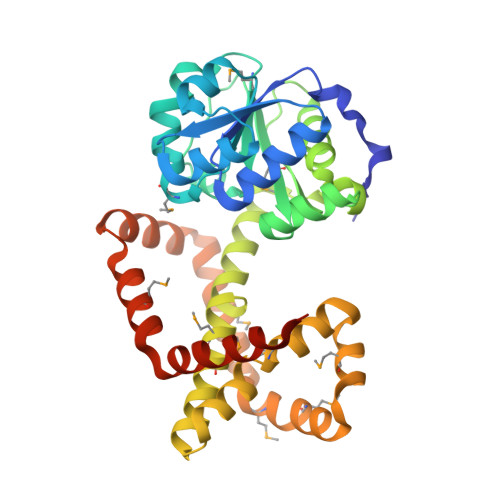NADH/NADPH bi-cofactor-utilizing and thermoactive ketol-acid reductoisomerase from Sulfolobus acidocaldarius
Chen, C.Y., Ko, T.P., Lin, K.F., Lin, B.L., Huang, C.H., Chiang, C.H., Horng, J.C.(2018) Sci Rep 8: 7176-7176
- PubMed: 29739976
- DOI: https://doi.org/10.1038/s41598-018-25361-4
- Primary Citation of Related Structures:
5YEQ - PubMed Abstract:
Ketol-acid reductoisomerase (KARI) is a bifunctional enzyme in the second step of branched-chain amino acids biosynthetic pathway. Most KARIs prefer NADPH as a cofactor. However, KARI with a preference for NADH is desirable in industrial applications including anaerobic fermentation for the production of branched-chain amino acids or biofuels. Here, we characterize a thermoacidophilic archaeal Sac-KARI from Sulfolobus acidocaldarius and present its crystal structure at a 1.75-Å resolution. By comparison with other holo-KARI structures, one sulphate ion is observed in each binding site for the 2'-phosphate of NADPH, implicating its NADPH preference. Sac-KARI has very high affinity for NADPH and NADH, with K M values of 0.4 μM for NADPH and 6.0 μM for NADH, suggesting that both are good cofactors at low concentrations although NADPH is favoured over NADH. Furthermore, Sac-KARI can catalyze 2(S)-acetolactate (2S-AL) with either cofactor from 25 to 60 °C, but the enzyme has higher activity by using NADPH. In addition, the catalytic activity of Sac-KARI increases significantly with elevated temperatures and reaches an optimum at 60 °C. Bi-cofactor utilization and the thermoactivity of Sac-KARI make it a potential candidate for use in metabolic engineering or industrial applications under anaerobic or harsh conditions.
Organizational Affiliation:
Department of Life Sciences, National Central University, Taoyuan, 32001, Taiwan. chinyuchen@cc.ncu.edu.tw.


















